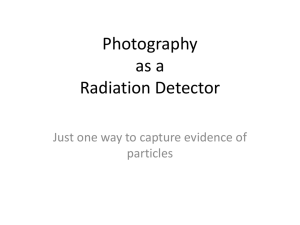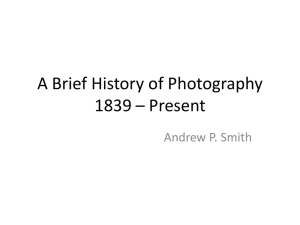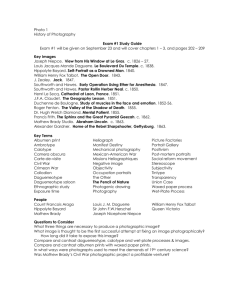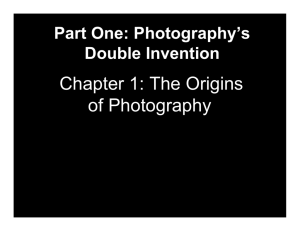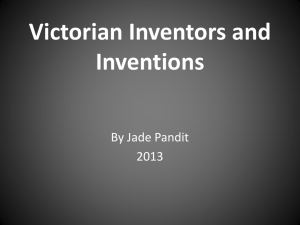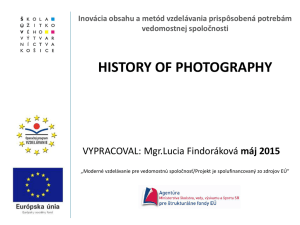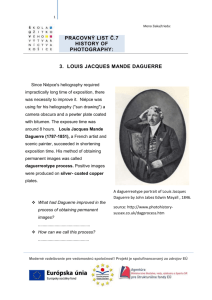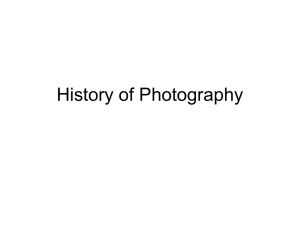File
advertisement
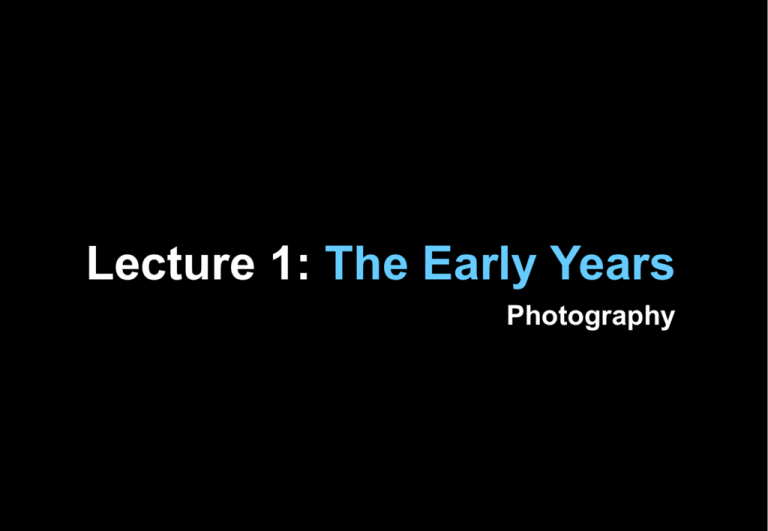
Lecture 1: The Early Years Photography “The photograph was the ultimate response to a social and cultural appetite for a more accurate and reallooking representation of reality, a need that had its origins in the Rennaisance” - Naomi Rosenblum, A World History of Photography In photography there is a reality so subtle that it becomes more real than reality. Alfred Stieglitz The search for realism During the Renaissance (16th Century), artists became increasingly interested in exploring and representing the reality of nature. Leonardo Da Vinci was particularly well known for his anatomical drawings and took a great in interest in contemporary advances in science. Camera Obscura In order to achieve such realism, artists developed various instruments to assist them in their quest for the perfect perspective. One such instrument used was the camera obscura, a dark room/space in which an inverted image was projected onto a surface. Camera Lucida As the technology developed, smaller more controllable apparatuses were developed such as the camera lucida, which were used as portable optical devices. The 19th Century As the industrial revolution transformed society in the 1800s with mass-production leading the way forward, scientists endeavored to reproduce reality in a fixed format. In 1827, the scientist Joseph Niépce was successful in fixing the first projected image of his view from his window in Le Gras, South France. Joseph Nicéphore Niépce View from His Window at Le Gras 1827 Louis Jacques Daguerre Louis Daguerre worked with Niépce in his quest to fix the projected image. Daguerre was a painter of stage sets and illusionistic scenery for The Diorama, a popular visual entertainment in Paris. Jean Baptiste Sabatier-Blot Portrait of Louis Jacques Mandé Daguerre 1844 The Daguerreotype In January 1839, Daguerre officially announced the invention of the Daguerreotype, a type of photograph which was laterally reversed and monochromatic printed onto a metal plate. Louis Daguerre Boulevard du Temple 1838 Competition Around the same time as the invention of the Daguerreotype, an English scientist called William Henry Fox Talbot developed another type of photograph called the Calotype. The Calotype had one distinct advantage over the Daguerreotype: it could be reproduced as a negative as opposed to being a single, unduplicatable image. Antoine Claudet Portrait of William Henry Fox Talbot 1844 A Question of Quality In terms of mass production, Talbot’s Calotype was far superior. However, it lacked the sharpness and overall quality to a Daguerreotype and this made it less popular in the early years, especially since many European countries and America had adopted Daguerre’s process. However, the Calotype was improved over time and advances in paper technology led to better processing. Thus, the Calotype soon became the most popular type of photography that is still used today. Talbot’s Photogenic Drawings Talbot’s initial photographic experiments involved producing photograms or, what he referred to as ‘Photogenic Drawings’. William Henry Fox Talbot Latticed Window at Lacock Abbey 1835 William Henry Fox Talbot Botanical Specimen 1839 Themes In the early years, many photographers were concerned with documentation and continued to focus on traditional fine art themes such as portraiture and landscape. Over time this changed as photographers started to assert their own identity, separate to that of contemporary artists. Antoine François Claudet The Geography Lesson 1850 Jean Baptiste Louis Gros Bridge and Boats on the Thames 1851 Valentin Gottfried Hunt Picture (Oil on canvas) Late 17th Century Adolphe Braun Still Life with Deer and Wildfowl 1865 EXERCISE Answer the following questions: 1) What is the difference between a ‘Camera Obscura’ and ‘Camera Lucida’? 2) Both a ‘daguerreotype’ and ‘calotype’ are a type of photograph, but what differentiates them? 3) Write a couple of paragraphs giving a brief early history of photography mentioning the main points discussed in the presentation. Cut out and use the handout picturesto illustrate your points. Consider the following points: - The Renaissance - Early inventions such as the Camera Obscura and Lucida - Industrial Revolution - Louis Jacques Daguerre and William Henry Fox Talbot - Competition between France & England - Themes in photography Annotate these images to tell the story of early history of photography by sticking them in your photo diary. HOMEWORK ASSIGNMENT 1. Find the oldest family photograph you can from home and do some research into the time in which it was taken. 2. You need to make a large copy of the image (a quality photocopy) and stick in your photo diary. 3. In your photo diary, write down a personal statement about the photo and explain how you think it differs from family portrait photographs taken today. End
